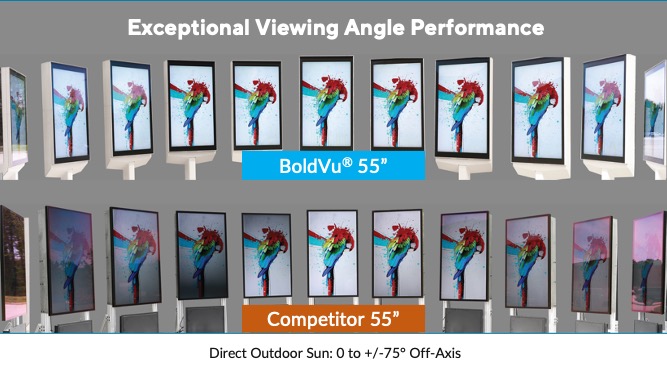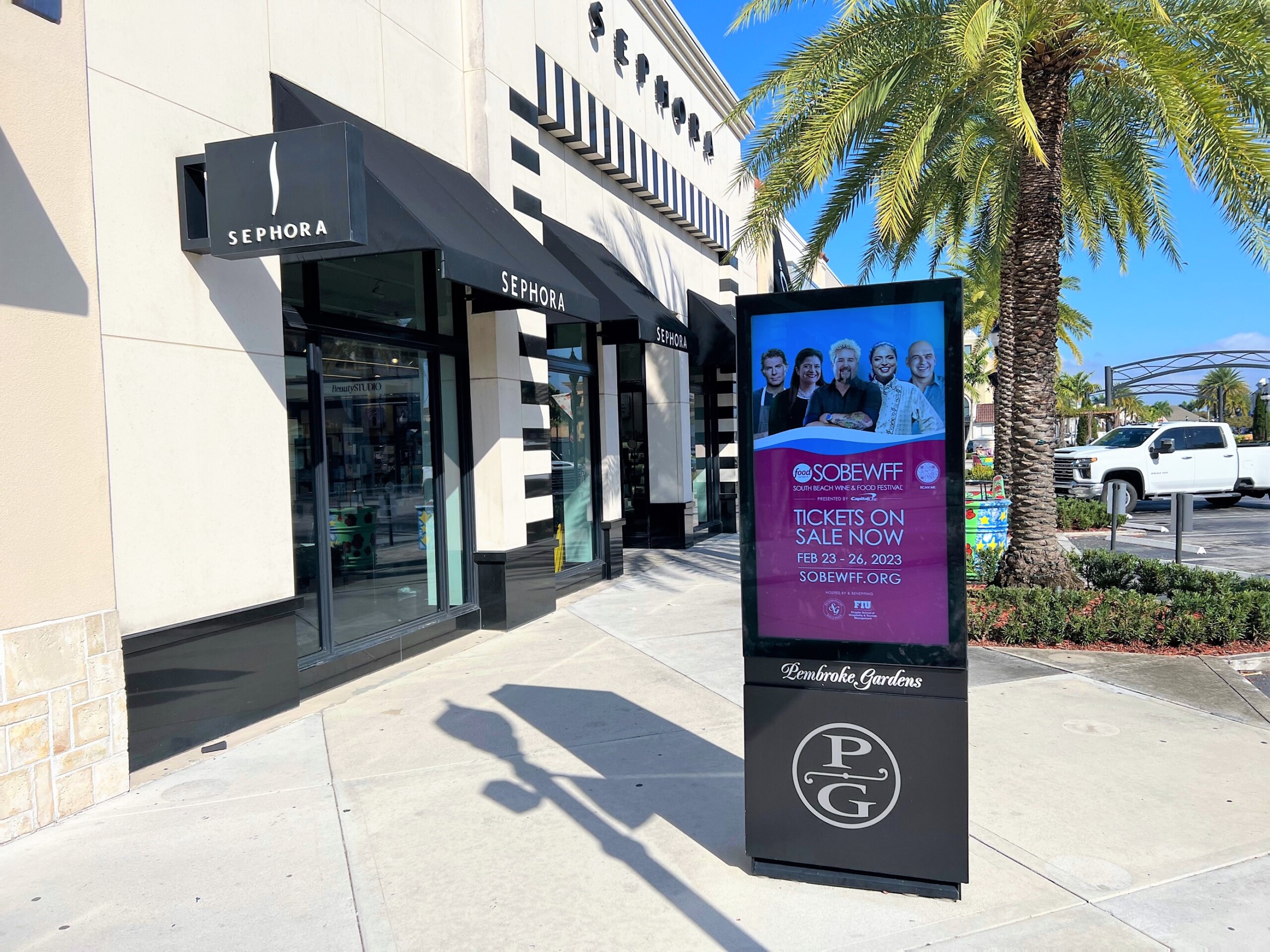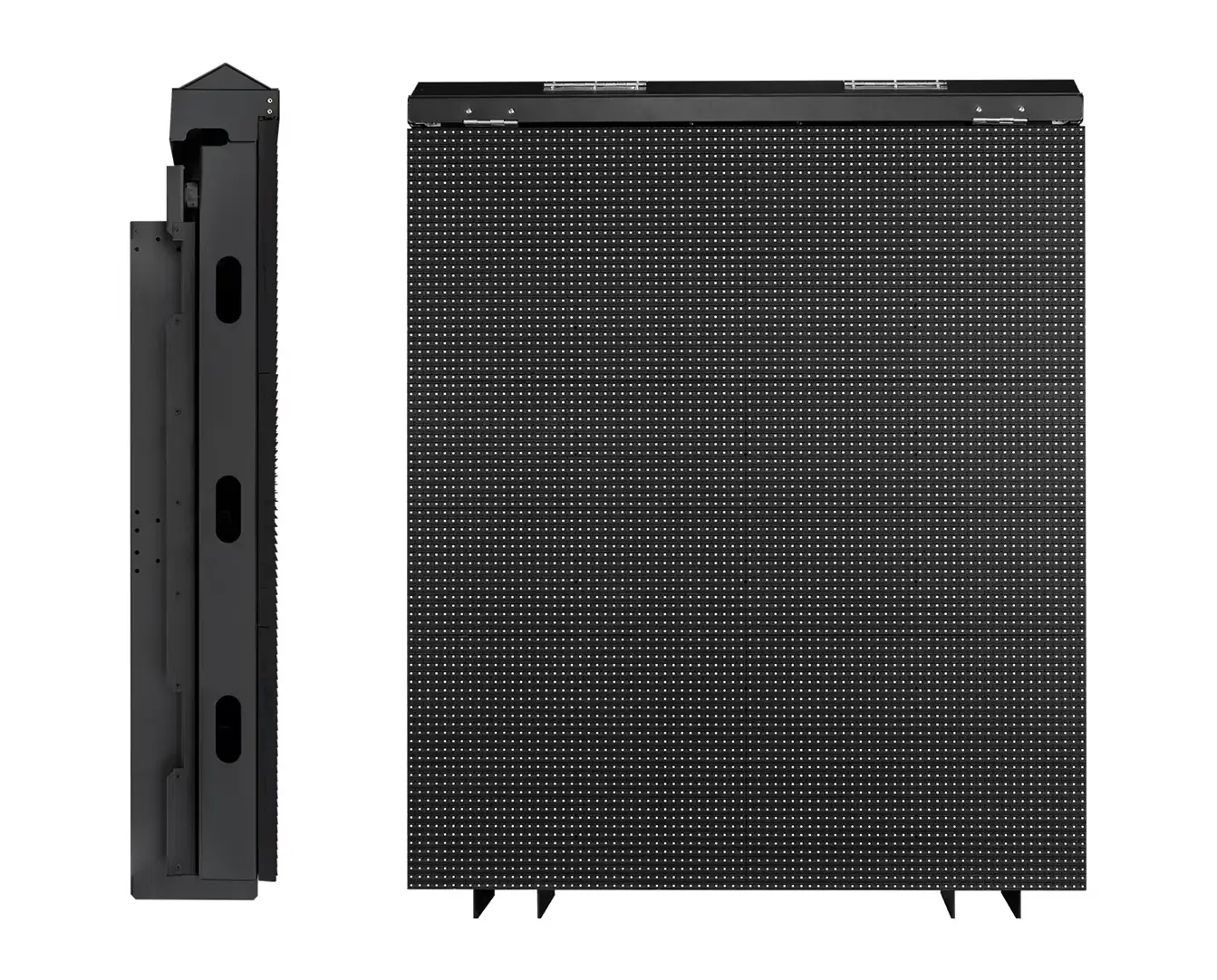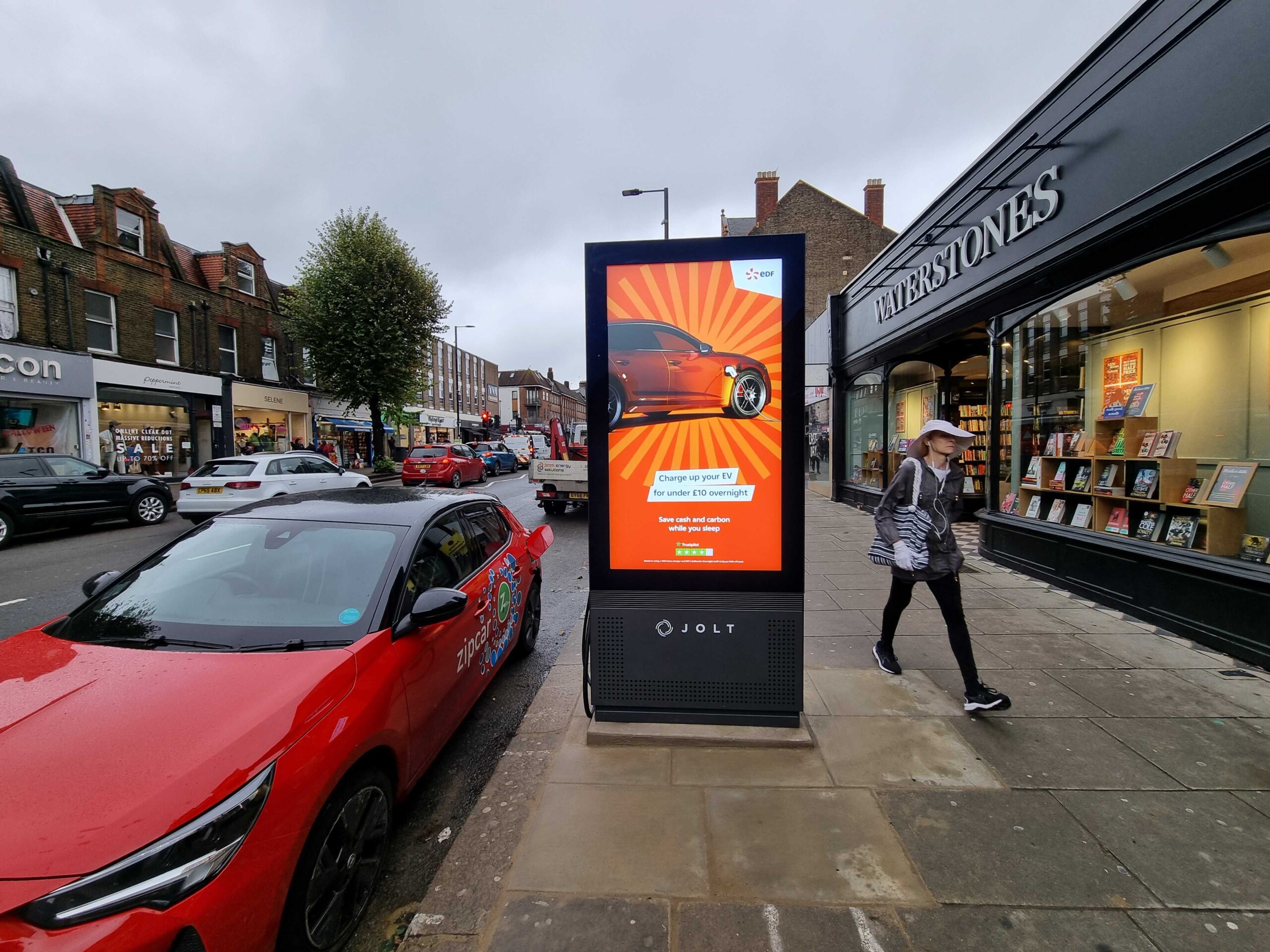UPDATED JUNE 16, 2025
In the world of consumer display technologies, the battle between LCD (Liquid Crystal Display), OLED (Organic Light Emitting Diode), and to a far lesser extent, direct view micro RGB LED (Red, Green, Blue Light-Emitting Diode) has been ongoing, each with its own strengths and weaknesses.
For outdoor advertising applications OLEDs are not a viable technology due to their relatively low APL (average picture level brightness … < 1000 nits), relatively high specular (mirror) reflection, and susceptibility to irreversible image sticking, image burn-in, or image retention when displaying relatively static images (i.e., ads).
This leaves only high bright LCDs and direct view mini/micro RGB LED as viable technologies for outdoor street furniture in the Digital Out of Home (DOOH) industry.
Manufacturing Resources International’s (MRI’s) decision to stick with LCD technology over direct view mini/micro RGB LED is a practical one, driven by a combination of image quality, image resolution, power consumption, cost-effectiveness, reliability, and longevity.
1. Image Contrast in Direct Sun:
By the very nature of the technology, direct view mini/micro RGB LEDs inherently exhibit excessive diffuse reflection (10 to 100 times greater than LCDs). This results in very poor image/color contrast when viewed in direct sun. The colors are muted and dull. Blacks are not black, but various shades of grey. At night, direct view Micro RGB LEDs look great, so long as they don’t have shorted failures which result in full bright, randomly scattered red, green, or blue pin points of light that inevitably grow in quantity over time.
About MRI
MRI was born in 2004 as an evolution from Avionic Displays Corporation (ADC) and American Panel Company (APC). ADC carries on today as Elbit Display Systems and APC carries on as Mercury Systems, both leaders in their field of LCD based displays used in the world’s military airborne and ground based systems, as well as commercial and business aviation. With the lessons learned from these “failure-not-an-option” harsh environments, MRI branched off into the world of Digital Out Of Home (DOOH) advertising with the BoldVu® product line.
We stand by our commitment of using commercial-grade, high temperature, outdoor rated LCD cells in our products and there are several important factors that allow us to achieve the industry’s only 10+ year lifetime performance.
LED stadium/arena score boards, as well as building and roadside billboards using direct view RGB LED can somewhat mitigate the extremely high diffuse reflection problem by using physical micro louvers (like venetian blinds) between successive rows of LEDs or “sun blocking eyelashes” (like the bill/visor of a ball cap) on individual LEDs. These displays are viewed from below at relatively far distances, with the observer looking up. In these cases, LED pixel pitch is relatively large (often 6mm or greater). This allows the individual rows of LED to be “shaded” from the sun by the physical micro louvers or “visors”. None of this is possible with street level mini/micro RGB LEDs. Hence the unacceptably poor image quality of street level mini/micro RGB LEDs in direct sun.
No technology yet discovered outperforms properly implemented LCDs for direct solar exposure daylight image quality.
The BoldVu® and BoldVu® XT mini-LED direct lit, blocked dimmed, LCD based products, with their 3500 nit or 5000 nit APL brightness respectively, combined with < 1% specular and <0.01% diffuse reflectance, provide world leading image performance in any lighting environment from direct sun to total darkness.
Black areas of the image on BoldVu® products are jet black and colors are bright, vivid, and saturated regardless of whether the BoldVu® is experiencing direct sun during the day or pitch black during the night.
2. Image viewing angle:
Direct view mini/micro-LEDs can offer good off angle viewing. However, all direct view LED displays are comprised of an x-y array of smaller (~ 6” x 6” up to maybe 12” x 12”) LED “tiles”. As the viewer moves off axis the seams between adjacent tiles become more visible and distracting. There can also be mechanical alignment issues with the LED tiles where picture elements crossing each tile boundary take a physical step or jump.
Direct view LEDs that attempt to increase image contrast and color saturation under daylight solar conditions by using micro-louvers or micro-visors/eyelashes have degraded off angle performance specifically due to the micro-shades.
Some outdoor LCD based displays offer poor off angle viewing. Those that employ infrared (IR) and/or ultraviolet (UV) optical filters on the cover glass in front of the LCD to combat overheating from solar exposure can look like red or blue mirrors, totally obscuring the displayed image when viewed off angle. Other LCD products may also use optical films in their backlight to achieve higher on-axis image luminance while sacrificing off-axis luminance and image contrast.
Many outdoor LCD products that attempt to compete with BoldVu® do not use anti-reflective (AR) cover glass and therefore exhibit excessive specular or mirror reflection.
As shown below, BoldVu® displays have been optimized for a superior viewing experience at any angle, under any degree of ambient illumination ranging from complete darkness to direct sunlight.

3. Image Resolution:
Street level displays need high resolution as they can be viewed from a distance as close as an arm’s length away. Today’s BoldVu® LCD based products provide pixel pitches ranging from 0.63 mm for the FHD 55” to 0.37 mm to 0.56 mm for the 65” to 98” UHD units.
Realistically, today’s highest resolution, semi-outdoor rated, direct view RGB LEDs range from 0.9 to 2.5 mm pitch. Mini/micro RGB LEDs are available in pixel pitches down to 0.5mm, but power, price, brightness, outdoor capability, and limited life/longevity currently make these mini/micro RGB LEDs not at all suited for outdoor application. This means that for street level displays, direct view LEDs cannot achieve FHD or UHD resolutions. The image will look very pixelated or grainy.
Specifically, direct view RGB LEDs are not at all suited to wayfinding applications due to their pixelated or grainy resolution. Small text required by wayfinding applications would be totally illegible when viewed on an RGB LED screen.
4. Power & Cost
The tighter the direct-view RGB LED pitch, the lower the luminance (darker image quality), the higher the product cost, and higher the power consumption. Both power and costs go up roughly as the square of the difference in LED pitch (i.e., dropping the LED pitch from 2.5 to 1.2mm will increase both power and cost by approximately (2.5/1.2)^2 = 4.34 x). Costs and power for the direct view mini/micro RGB LED displays will range from 2X to 4X times as much as a BoldVu® LCD product.
5. Reliability & Longevity:
Direct view mini/micro RGB LED displays are still relatively immature as a technology and industry. RGB LEDs are prone to individual red, green or blue failed, stuck on or stuck off pixels. Stuck off is not too offensive, until they become clustered or excessive, as they are black. Stuck on is another story, particularly at night, as they are stuck typically at full brightness.
RGB LED displays are formed by many small blocks or tiles abutted next to each other. Each tile must be calibrated to match adjacent tiles in color, luminance, and grey scale. Poor calibration and/or replacement of individual tiles due to failures over time result in a “patchwork quilt” look to the overall image.
Even when new and viewed in daylight, as discussed above, the diffuse reflection of RGB direct view LEDs is poor, with degraded black levels, image contrast and color saturation. As the direct view RGB display ages the diffuse reflection, and therefore image quality, becomes progressively worse. Solar exposure, excess temperatures, oxidation, electrostatic attraction of airborne dust and/or dust deposits left behind from evaporating rainwater degrade the “black” materials surrounding each RGB LED turning them ever lighter shades of grey.
RGB direct view LED displays, as the name implies, are made up of millions of individual red, green, and blue LEDs. Each color has a different rate of degradation. When new, RGB LED may look very good, with a pleasing white balance. However, as they age, particularly the blue LEDs diminish more rapidly than the red and green, resulting in a shift of the entire display color spectrum towards yellow.
When considering a mini/micro RGB LED solution, be sure to understand the manufacturers’ specifications on life. In outdoor applications, many manufacturers rate the L50 (i.e. time to 50% of brand-new brightness) as low as 10,000 hours. If you do the math, 10,000 hours is roughly 1 year of continuous 24/7 operation. Considering that any given outdoor display is at or near maximum luminance for about 12 hours per day, 10,000 hours would equate to the RGB LED display being able to provide only ½ of its initial brightness within 2 years of deployment. Considering that image contrast is equal to image brightness/(black image level + ambient reflections) and the fact that the RGB LED brightness is diminishing rapidly over time, while the black level and ambient reflections are rising over the same time due to material degradation/oxidation in the sun and dust accumulation, micro/mini RGB LED image contrast, which starts out poor, will degrade very rapidly over a relatively short period of time.
Outdoor LCDs have gained an underserved reputation of being unreliable and short lived. This is true for any displays (LCDs or micro RGB LEDs) that are not properly sealed, cooled, monitored, and managed.
BoldVu® by MRI has proven this does not have to be the case. With more than 3 decades of experience and knowledge, 17 generations of product evolution, and nearly 30,000 BoldVu® digital display faces deployed globally in every imaginable environmental and weather extreme, BoldVu® is the time tested, proven, long lived outdoor display product solution.
As the saying goes, to put our money where our mouth is, BoldVu® is the only product in the industry that guarantees 10 full years of image performance. For 10 years of 24/7 operation, no perceptible loss of luminance, color saturation, viewing angle or shift in color temperature.
6. Repairability
There seems to be a misconception that RGB LEDs are easier to repair than LCDs. All you need to do with an RGB LED display is “pluck out” the failed LED tile or module and insert a new one. Well for starters, the “new” replacement module will not be color or luminance matched to the surrounding “old” tiles and neither will it be aged (i.e., color shifted). Therefore, the “new” tile or module will stick out like a sore thumb and over time, with multiple tile or module replacements, the entire image area begins to look like a patchwork quilt. Also, it is often troublesome to mechanically align the “new” tiles with “old” abutting tiles, resulting in images taking a step across the tile boundaries. These LED “replacement” tiles are also surprisingly expensive and, in some cases, more expensive than replacing an entire LCD cell.
Mini/Micro RGB LEDs are very fragile. At street level RGB LEDs need to be protected behind an IK10 impact resistant coverglass to keep them from easily being vandalized … just like LCDs.
Some DOOH LCDs are directly optically bonded to their protective coverglass. Most DOOH LCDs use “high bright” LCD modules. The cost of replacing an optically bonded high bright LCD module in the field is extremely expensive, if it is even possible.
This is one of many reasons why BoldVu® DOOH LCDs DO NOT have optically bonded, but air gapped IK10 cover glass. BoldVu® also does not use “high bright LCD modules”. For more than 20 years and over tens of thousands of deployed DOOH LCD products, BoldVu® is specifically designed for the LCD cell, which does not include the backlight, to be economically replaced in the field.
It is safe to say that replacing an LCD cell on a BoldVu® is likely comparable in time and lower in material costs than replacing a street level direct view RGB LED module.
BoldVu® Gen 17 is the only globally available outdoor display product that comes with a performance guarantee. When properly maintained by MRI through a service level agreement (SLA), BoldVu® is guaranteed to maintain day 1 visual performance (i.e., brightness, color saturation, image contrast, viewing angle, etc.) when operating 24/7/365 for the term of the SLA up to 10 years. No ands, ifs, or buts…
Beginning with BoldVu® Gen 17, no more:
a. LCD cell breach (i.e., black circles or bubbles in your display image)
b. Gravity mura (i.e., brown to yellow discoloration across the bottom of your display image)
c. LCD solar clearing (i.e., blackening of areas of the LCD when exposed to the sun)
d. Browning/Yellowing of the display image from excessive heating of the LCD and/or backlight components
e. Dust or moisture ingress I.e., all BoldVu® products are IP66 sealed with 24/7 internal air pressure sensing and reporting via internet communications
f. Black images when viewed through polarized sunglasses (excludes BoldVu® 98” products)
g. Photoconductivity (i.e., areas of the displayed image turning milky white/dark grey when exposed to direct sun)
h. Image retention or sticking, so long as static content is not displayed for prolonged periods of time and the BoldVu® LCD Rejuvenation pattern is invoked daily during “off” hours.
In conclusion, BoldVu® by MRI’s choice of LCD technology over LED/OLED is a strategic decision based upon a combination of factors that prioritize image fidelity, preservation of image fidelity over 10+ years of operation, cost-effectiveness, power efficiency, reliability, and technological maturity.
While a consumer OLED TV may wow at home, it is not a technology ready for 24/7/365 use in exposed outdoor environments. Also, while the various display technology manufactures may expound upon the “wow” factor of the large area micro RGB LED direct view displays, they downplay the costs, power consumption, reliability, or even view-ability in a brightly lit room …and certainly do not see them as a viable outdoor all-weather display.
BoldVu® by MRI displays are purpose built from the outset using only commercial grade, high temperature LCD cells in an IP66 sealed (no dust or moisture intrusion) chassis achieving superior direct-sun viewable sharpness, high-contrast color, and power efficiency that is maintained throughout the lifetime of the product.
Not only is BoldVu® the highest image quality, longest lived, most reliable, lowest power, quietest, maintenance free (no air filters), all weather, direct outdoor street-level display product available today, it is also by far, the lowest total cost of ownership (TCO). This lowest TCO is based upon the sum of the acquisition cost, installation cost, maintenance cost, longevity (no need for replacement for 10+ years), on-site service cost, and cost of power over the installed life of the display.
In short, BoldVu® is THE ideal street level DOOH solution!



